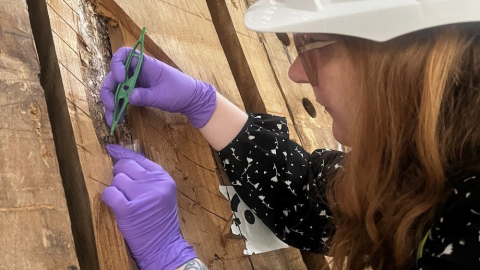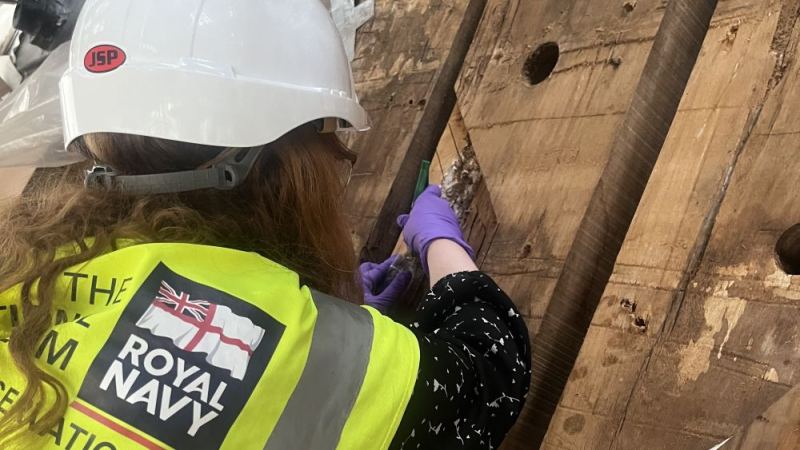Latest news from the Conservator for HMS Victory: The Big Repair
- View news filtered by: 21st Century
- View news filtered by: Ships and Aircraft
- View news filtered by: HMS Victory
- View news filtered by type: Interview

HMS Victory: The Big Repair is more than just conserving the historic ship for future generations, but discovering 260 years' worth of stories as we peel back the layers of its history. As we share our research across the globe, our expert team at the National Museum of the Royal Navy will continue to share their stories during the project.
This month, conservator at the National Museum of the Royal Navy, Karoline Sofie Hennum, shares updates about the challenges of conserving a historic ship, particularly on a project of this scale.
What is a typical day like working as a heritage conservator?
Working as conservator for HMS Victory: The Big Repair is incredibly exciting, and no day is ever the same.
As HMS Victory has suffered extensive damage as a result of water ingress and from constant exposure to the elements, a lot of my time is spent dealing with issues such as completing routine condition assessments of affected areas, continuing the integrated pest management and environmental monitoring.
I often have to respond to these issues in a more responsive way. For example, either using fungicidal treatment or safe insecticides. Recently, I have, with the assistance of our two shipkeepers, been working on clearing and cleaning areas on the ship where internal work is about to commence.
What is the best part of working as part of the team on The Big Repair?
I love working closely with the wider project team, and I often assist shipwrights and riggers with specific tasks. It is great to work collaboratively, and I am incredibly fortunate that I get to learn more about traditional crafts, such as wooden boatbuilding and rigging, while also using my own conservation skills.
What are you working on at the moment?
I am currently in the middle of testing ahead of a ‘block-lift’, which I am planning to undertake soon with our archaeologist. In archaeology, a block-lift means vertically lifting an archaeological artefact out of the ground with the surrounding sediment still holding it together as a bigger block.
What challenges are you expecting when you carry out this archaeological process?
A small section of one of the historic futtocks on the port side of the ship has, unfortunately, due to its age and exposure to the elements, suffered irreversible and irreparable damage. As the item is beyond repair, leaving it in its current location would have implications on the surrounding hull structures and would have a negative impact on its historic significance.
The plan is therefore to retrieve the futtock section from its current location without causing any further damage and while still protecting it and maintaining its current shape.
As this block-lift will be carried out in a less traditional way, it is important that I implement a method that will offer the futtock the same kind of support that it would have had naturally if it were buried in the ground.
There’s an array of requirements to consider. For example, the process must be reversible (where all lifting and support materials can be removed if necessary), minimal to no interference with the historic wood (to allow for scientific sampling and research in the future) and ensure complete stability within the futtock’s structure.
It will be quite the challenge undertaking this task, but thorough material testing and multiple trial runs will ensure it is a successful process.
Want to see The Big Repair take place in real time?
HMS Victory remains open to the public during The Big Repair, where visitors can continue to get on board the ship, with the added opportunity to watch the conservation project take place in real time from a three-storey viewing platform.
To find out more about HMS Victory: The Big Repair, visit our dedicated information hub, where we share the latest project updates, milestones, and stories.
